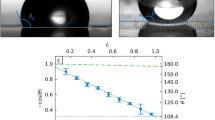Abstract
Since the pioneering works of Wenzel and Cassie Baxter in the 1930s, and now with the trivialization of the micro- and nanotechnology facilities, superhydrophobic surfaces have been announced as potentially amazing components for applications such as fluidic, optical, electronic, or thermal devices. In this paper, we show that using superhydrophobic surfaces in digital microfluidic devices could solve some usual limitations or enhance their performances. Thus, we investigate a specific monophasic (air environment) microfluidic device based on electrowetting integrating either a hydrophobic or a superhydrophobic surface as a counter-electrode. The droplet transport using a superhydrophobic surface compared with a classical hydrophobic system led to some original results. Characterization of the dynamic contact angle and the droplet shape allows us to get new insight of the fluid dynamics. Among the remarkable properties reported, a 30 % lower applied voltage, a 30 % higher average speed with a maximum instantaneous speed of 460 mm/s have been measured. Furthermore, we have noticed a huge droplet deformation leading to an increase by a factor 5 of the Weber number (from 1.4 to 7.0) on SH compared to hydrophobic surfaces. Finally, we discuss some of the repercussions of this behaviour especially for microfluidic device.







Similar content being viewed by others
References
Abdelgawad M, Park P, Wheeler AR (2009) Optimization of device geometry in single-plate digital microfluidics. J Appl Phys 105(9):094, 506–507. doi:10.1063/1.3117216
Au SH, Kumar P, Wheeler AR (2011) A new angle on pluronic additives: advancing droplets and understanding in digital microfluidics. Langmuir 27(13):8586–8594. doi:10.1021/la201185c
Bavière R, Boutet J, Fouillet Y (2008) Dynamics of droplet transport induced by electrowetting actuation. Microfluid Nanofluid 4(4):287–294. doi:10.1007/s10404-007-0173-4
Bocquet L, Lauga E (2011) A smooth future? Nat Mater 10(5): 334–337. doi:10.1038/nmat2994
Brzoska JB, Brochard-Wyart F, Rondelez F (1993) Motions of droplets on hydrophobic model surfaces induced by thermal gradients. Langmuir 9(8): 2220–2224. doi:10.1021/la00032a052
Coffinier Y, Janel S, Addad A, Blossey R, Gengembre L, Payen E, Boukherroub R (2007) Preparation of superhydrophobic silicon oxide nanowire surfaces. Langmuir 23(4):1608–1611
Dufour R, Brunet P, Harnois M, Boukherroub R, Thomy V, Senez V (2012) Zipping effect on omniphobic surfaces for controlled deposition of minute amounts of fluid or colloids. Small 8(8):1229–1236. doi:10.1002/smll.201101895
Eral HB, Augustine DM, Duits MHG, Mugele F (2011) Suppressing the coffee stain effect: how to control colloidal self-assembly in evaporating drops using electrowetting. Soft Matter 7(10):4954–4958. doi:10.1039/C1SM05183K
Galopin E, Piret G, Szunerits S, Lequette Y, Faille C, Boukherroub R (2010) Selective adhesion of bacillus cereus spores on heterogeneously wetted silicon nanowires. Langmuir 26(5):3479–3484. doi:10.1021/la9030377
Grosse S, Schroder W (2008) Dynamic wall-shear stress measurements in turbulent pipe flow using the micro-pillar sensor mps3. Int J Heat Fluid Flow 29(3):830–840. http://www.sciencedirect.com/science/article/B6V3G-4S0HC0X-1/2/f1538e7159589d0351677b042da38325
Jonsson-Niedziolka M, Lapierre F, Coffinier Y, Parry SJ, Zoueshtiagh F, Foat T, Thomy V, Boukherroub R (2011) Ewod driven cleaning of bioparticles on hydrophobic and superhydrophobic surfaces. Lab Chip 11(3):490–496. doi:10.1039/C0LC00203H
Ko S, Lee H, Kang K (2008) Hydrodynamic flows in electrowetting. Langmuir 24(3):1094–1101
Lapierre F, Brunet P, Coffinier Y, Thomy V, Blossey R, Boukherroub R (2010) Electrowetting and droplet impalement experiments on superhydrophobic multiscale structures. Faraday Discuss 146:125–139. doi:10.1039/b925544c
Lapierre F, Piret G, Drobecq H, Melnyk O, Coffinier Y, Thomy V, Boukherroub R (2011) High sensitive matrix-free mass spectrometry analysis of peptides using silicon nanowires-based digital microfluidic device. Lab Chip 11(9):1620–1628. doi:10.1039/C0LC00716A
Lu HW, Glasner K, Bertozzi AL, Kim CJ (2007) A diffuse-interface model for electrowetting drops in a hele-shaw cell. J Fluid Mech 590:411–435
Maali A, Bhushan B (2012) Measurement of slip length on superhydrophobic surfaces. Phil Trans R Soc A 370(1967):2304–2320
Malic L, Brassard D, Veres T, Tabrizian M (2010) Integration and detection of biochemical assays in digital microfluidic loc devices. Lab Chip 10(4):418–431. doi:10.1039/b917668c
Malk R, Fouillet Y, Davoust L (2009) Rotating flow within a droplet actuated with ac ewod. Procedia Chemistry 1(1):1107–1110. doi:http://www.sciencedirect.com/science/article/B983C-4X49BRW-9W/2/1e1be9bf61884d5c0eae360c29438bb3
Mugele F, Baret JC (2005) Electrowetting: from basics to applications. J Phys Condens Matter 17(28):R705–R774. http://stacks.iop.org/0953-8984/17/R705
Nelson WC, Sen P, Kim CJC (2011) Dynamic contact angles and hysteresis under electrowetting-on-dielectric. Langmuir 27(16):10319–10326. doi:10.1021/la2018083,
Oh JM, Ko SH, Kang KH (2008) Shape oscillation of a drop in ac electrowetting. Langmuir 24(15):8379–8386. doi:10.1021/la8007359
Perry G, Thomy V, Das MR, Coffinier Y, Boukherroub R (2012) Inhibiting protein biofouling using graphene oxide in droplet-based microfluidic microsystems. Lab Chip 12(9):1601–1604. doi:10.1039/C2LC21279J
Piret G, Coffinier Y, Roux C, Melnyk O, Boukherroub R (2008) Biomolecule and nanoparticle transfer on patterned and heterogeneously wetted superhydrophobic silicon nanowire surfaces. Langmuir 24:1670–1672
Schertzer M, Gubarenko S, Ben Mrad R, Sullivan P (2010a) An empirically validated model of the pressure within a droplet confined between plates at equilibrium for low bond numbers. Exp Fluids 48:851–862. doi: 10.1007/s00348-009-0773-8
Schertzer MJ, Gubarenko SI, Ben-Mrad R, Sullivan PE (2010b) An empirically validated analytical model of droplet dynamics in electrowetting on dielectric devices. Langmuir 26(24):19230–19238. doi:10.1021/la103702t
Verplanck N, Coffinier Y, Thomy V, Boukherroub R (2007a) Wettability switching techniques on superhydrophobic surfaces. Nanoscale Res Lett 2(12):577–596. doi:10.1007/s11671-007-9102-4,
Verplanck N, Galopin E, Camart JC, Thomy V, Coffinier Y, Boukherroub R (2007b) Reversible electrowetting on superhydrophobic silicon nanowires. Nano Lett 7(3):813–817
Zhang J, Han Y (2009) dual-parallel-channel shape-gradient surfaces: Toward oriented and reversible movement of water droplets. Langmuir 25(24):14195–14199. doi:10.1021/la9014898
Zhang J, Lu X, Huang W, Han Y (2005) Reversible superhydrophobicity to superhydrophilicity transition by extending and unloading an elastic polyamide film. Macromol Rapid Commun 26(6):477–480. doi:10.1002/marc.200400512
Acknowledgments
The Centre National de la Recherche Scientifique (CNRS), the Defence Science and Technology Laboratory (Porton Down, United Kingdom) and the European Community Seventh Frame-work Programme (FP7/2007–2013) under grant agreement no. 227243 are gratefully acknowledged for financial support. The authors thank F. Zoueshtiagh and P. Brunet for their kind support during the visualizations and G. Piret for her kind support for superhydrophobic surfaces realization.
Author information
Authors and Affiliations
Corresponding author
Rights and permissions
About this article
Cite this article
Lapierre, F., Jonsson-Niedziolka, M., Coffinier, Y. et al. Droplet transport by electrowetting: lets get rough!. Microfluid Nanofluid 15, 327–336 (2013). https://doi.org/10.1007/s10404-013-1149-1
Received:
Accepted:
Published:
Issue Date:
DOI: https://doi.org/10.1007/s10404-013-1149-1




